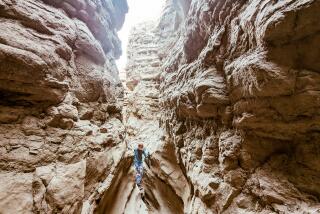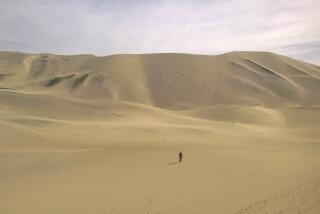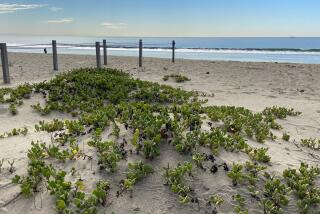Shifting With New Mexico’s White Sands of Time : Gypsum Dunes Within National Monument Provide Contrast to Adjacent Missile Range
- Share via
ALAMOGORDO, N.M. — I was standing on the crest of a 60-foot dune of pure white sand, watching the setting sun turn the sky to myriad shades of red and purple. Behind me, the sand cascaded to a flat desert of saltbrush and yucca, while before me the dunes marched away until their shapes blurred to a uniform band of sterile white, fading into a distant range of mountains sharply etched against the sunset.
I knew that more mountains soared nearly 8,000 feet above me to the east, but at the moment they were largely obscured by a heavy rainstorm which shortly before had spattered moisture on the desert, cooling the reflecting oven heat of a June afternoon.
I was in a place of special magic called White Sands National Monument, near Alamogordo, N.M.
For most people, the name White Sands conjures up thoughts of the White Sands Missile Range, which hems in the monument on three sides and is renowned for the fact that it was here, on July 16, 1945, that the first atom-bomb test propelled an unknowing world into the atomic era. (See related story, “Visitors Still Flock to Trinity Site,” on page L22.) Since that time, the Army has continued to use the missile range to throw fiery spears across the desert, testing both its weapons of destruction and peaceful efforts toward space exploration.
But for me, White Sands evokes thoughts of dunes the color of driven snow, a place where--especially after the summer tourists have departed--you can walk a quarter-mile from your car and feel that you have hundreds of square miles of desert and dune virtually to yourself.
Administered by the National Park Service as a monument since 1933, White Sands was once ocean bottom until, in the slow-motion drama that characterizes the geology of the West, it was converted to a lake bed rich in the mineral gypsum--the same material used to make plasterboard walls. Today, the lake has turned to desert, and the gypsum has become sand.
But as I stood atop the dune, I wasn’t thinking about geology. I was alone, hiking the monument’s principal trail, the Big Dune Nature Trail, along which a series of poles planted in the sand led me on a one-mile circuit that began at the leading edge of the dunes and eventually climbed to the top of one of the higher summits.
A gentle breeze tickled my face, and I stooped to pick up a handful of sand, tossing it in the air to watch it drift--a shimmering mixture of fine particles and dust. The ease with which the sand blows in the wind, I thought to myself, is what keeps the dunes alive and moving.
The dunes at White Sands are not particularly tall. It is their color that makes them unusual.
On a previous visit, I’d driven the monument’s only road, an eight-mile, mostly paved, “Heart of the Dunes” scenic drive (which also makes an excellent jog or bike ride) to the center of the dune field, where I discovered a vast panorama of surrealistic bleached-white shapes that seemed to flow away into the distance--an unearthly landscape whose principal features were the simplicities of form and arrested motion.
The stark white color comes from the fact that the dunes are composed of nearly pure gypsum, rather than the quartz crystals usually found in beach sand. Covering nearly 300 square miles, the gypsum dunes at White Sands comprise the largest such field in the world.
Sand dunes, whether gypsum or quartz, are the product of wind, time and a harsh enough climate to retard the growth of vegetation that would otherwise stabilize the sand and halt its advance. There must also be a continuing source of sand.
White Sands has all these ingredients in abundance. During the day, a light breeze blows frequently, covering the surface of the dunes in endlessly shifting patterns of ripples, carrying enough sand in its wake that sometimes dune surfaces appear blurred by the constantly shifting particles. But the real dune-building occurs in the spring, when the wind can blast at a steady 45 m.p.h., lifting enough sand into the air to blot out the horizon in a true dust storm.
The dunes replenish themselves from a gypsum alkali flat on the west side of the monument. More gypsum (including some washed down during the rainy season, when floods transform a portion of the monument into large, shallow Lake Lucero) consists of a mineral known as selenite, which is a translucent tan in color.
The selenite gradually disintegrates as temperature changes cause thumbnail-sized flakes to break away. The wind sets them tumbling, and as they begin their inexorable migration northeastward, they change from brown to white as they accumulate tiny white scratches. Gradually, they break down into into finer and finer particles, becoming as white as the gypsum in the alkali flat. The most active dunes can advance a dozen or more feet a year, and the scenic drive must be constantly plowed, as though it were a mountain road subject to frequent blizzards.
But much of the year, the climate in White Sands is anything but blizzard-like. Total precipitation amounts to less than 10 inches, and summer temperatures--measured in the virtually nonexistent shade--can soar as high as 110 degrees, though in July mid-90s are more typical.
September and October are among the best times of year to visit, with temperatures cooler but still warm enough to be pleasant. It’s also a great time for photographers, as the autumn colors of scattered cottonwoods growing near the edge of the dune field provide golden contrasts to the white sand. Even winter can be a good time to visit. December and January highs average 57 degrees, with lows of 23. The windy season is February to mid-April.
Over spring break, the area is popular with college students, and can draw thousands of visitors a day. Unless you’re looking for a beach atmosphere, go some other time.
But the dunes are a great place to watch smaller children romp in the sand, or even--as I had done on my previous visit--to shed the burden of adulthood and do so yourself, struggling up the steep, loose slope of a dune’s leading edge--called its “slipface” by geologists--only to plunge back down again in a barely controlled avalanche of sliding sand and flailing limbs.
The Park Service encourages such play, having constructed a series of large picnic areas at the end of the “Heart of the Dunes” drive, and allowing people to hike at will, safe in the knowledge that the next strong wind will remove all traces of their footprints. It’s a far cry from the “stay on the trail” admonitions at many other national parks and monuments; at White Sands, there are few trails but plenty of places to hike.
Although the slipface of an active dune is probably one of the most lifeless environments on Earth, the White Sands dune field is anything but lifeless. As I walked along the leading edge of the dunes, I saw yucca plants struggling to grow quickly enough to keep from being buried, while in short-lived hollows between successive waves of dunes, the saltbrush desert attempted to reassert itself.
Even on the windward slopes of some of the dunes themselves, vegetation eked out a living in scattered clumps. These clumps of plant life often formed raised pedestals several feet above the surrounding surface, where the tenacious roots of a yucca plant or a desert sumac had temporarily held back the sand from its constant motion.
Animals live here as well. Some--most notably the tiny Apache pocket mouse and the “bleached” earless lizard--are the white of the sand, perfectly adapted to hide from predators. They also hid from me; I saw none of them. But frequently, I found the zigzagging tracks of various birds, lizards, rodents and beetles. Animal-track watching, a ranger later told me, is a favorite sport here, especially in the morning--before the wind has had time to erase the evidence of the night’s activities.
For more adventurous visitors, the monument offers a back-country campsite, where campers can walk about a third of a mile from the scenic drive to camp on the sand. Or there are monthly, ranger-guided trips across a corner of the missile range to Lake Lucero, where large, angular gypsum crystals (from one inch to several feet in length) ring the lake bed in an eerie landscape.
A monument visitor center has bathrooms, a bookstore, museum and gift shop (with fountain drinks and microwaved sandwiches).
The entire monument except for the visitor center is closed for safety purposes during missile tests on nearby parts of the White Sands Missile Range. Closures, which typically last less than an hour, occur an average of one to two times a week, seldom on weekends. Usually, they are scheduled several weeks in advance, but sometimes there is less than 24 hours’ notice. Visitors planning to use the backcountry campsite should inquire in advance.
And once a month, May through October, the monument celebrates the full moon by remaining open later than usual (until 11 p.m.), so visitors can experience the dunes under the eerie lunar light. The last program this year--featuring a sunset stroll and evening presentation--is scheduled for Saturday night, Oct. 10.
GUIDEBOOK
White Sands National Monument
Getting there: White Sands National Monument lies about 15 miles southwest of Alamogordo on U.S. 70 in south-central New Mexico. The entrance is well-marked.
The monument: A visitor center at the monument entrance is open 8 a.m.-7 p.m. summers, 8 a.m.-4:30 p.m. the rest of the year. The dune field itself is open until 30 minutes after sunset from Labor Day to Memorial Day, until 10 p.m. Memorial Day to Labor Day. Only people using the walk-in campground may remain after closing. The scenic drive generally opens at about 7 a.m.; admission is $3 per vehicle.
Programs and tours: Late afternoon is a good time to visit, especially during the summer (Memorial Day-Labor Day), when there is a ranger-guided hike shortly before sunset and an evening slide presentation at the picnic area. Other ranger-guided activities are held on occasion, but are rare during the off-season; phone or ask at the visitor center for information.
Lake Lucero tours are traditionally held on the last Saturday or Sunday of the month. The lake is in the monument, but the access road crosses the missile range, so the lake can only be visited with a guide. The tour begins 30 miles west of the monument on U.S. 70, and involves a 20-minute drive. Allow four hours and bring lunch and drinking water.
Remaining tour dates for 1992 are: next Saturday (10 a.m.), Oct. 25 (10 a.m.), Nov. 28 (10 a.m. and 2 p.m. if there is sufficient interest) and Dec. 27 (2 p.m.). Reservations can be made by phoning the visitor center, beginning two weeks in advance. The free tours are popular and can fill within three or four days.
Where to stay: Other than the free walk-in campground (limit 25, may fill at full moon), there are no overnight accommodations in the monument. Alamogordo, however, is a city of 28,000 people, and Las Cruces, 54 miles southwest of the monument, is nearly twice as large.
For more information: Contact White Sands National Monument, P.O. Box 458, Alamogordo, N.M. 88310, (505) 479-6124. For information about Alamogordo, call (505) 437-6120; for Las Cruces, (505) 524-1968.
More to Read
Sign up for The Wild
We’ll help you find the best places to hike, bike and run, as well as the perfect silent spots for meditation and yoga.
You may occasionally receive promotional content from the Los Angeles Times.






